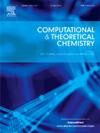Modulation of the optoelectronic properties of h-BN/ WTe2 heterostructures with different twist angles by biaxial strain
IF 3
3区 化学
Q3 CHEMISTRY, PHYSICAL
引用次数: 0
Abstract
Constructing a vertical van der Waals heterostructure can effectively regulate the properties of a single 2D material. This paper constructs a vertical h-BN/WTe₂ heterostructure and uses first-principles methods based on density functional theory to explore the effects of twist angle and biaxial strain on its stability, electronic properties, and optical performance. The results show that the twist angle does not change the direct bandgap and type-I band alignment of the h-BN/WTe₂ heterostructure, but it affects the bandgap size and the positions of the conduction band minimum (CBM) and valence band maximum (VBM). The maximum value of the bandgap occurs at twist angles of 8.9° and 51.1°, with a value of 1.21 eV. Additionally, for the h-BN/WTe₂ heterostructure at a twist angle of 0°, the maximum optical absorption coefficient is 9.5 × 105 cm−1 at 5.38 eV. As the twist angle changes from 0° to 8.9° and 30°, the optical absorption spectrum redshifts, and the absorption coefficient decreases. Furthermore, within the strain range of −12 % to +12 %, the bandgap type of the h-BN/WTe₂ heterostructure changes from indirect to direct and then back to indirect, and a semiconductor-metal phase transition also occurs. The research results provide theoretical guidance for the use of the h-BN/WTe₂ heterostructure in optoelectronic devices, aiding its further development in the field of optoelectronic device applications.

双轴应变对不同扭角h-BN/ WTe2异质结构光电性能的调制
构建垂直范德华异质结构可以有效地调节单个二维材料的性能。本文构建了h-BN/WTe₂垂直异质结构,利用基于密度泛函理论的第一性原理方法,探讨了扭转角和双轴应变对其稳定性、电子性能和光学性能的影响。结果表明,扭转角不会改变h-BN/WTe₂异质结构的直接带隙和i型带向,但会影响带隙大小和导带最小值(CBM)和价带最大值(VBM)的位置。带隙的最大值出现在扭转角8.9°和51.1°时,为1.21 eV。另外,当扭转角为0°时,h-BN/WTe 2异质结构在5.38 eV下的最大光吸收系数为9.5 × 105 cm−1。当扭转角从0°变为8.9°和30°时,光吸收光谱红移,吸收系数减小。在−12% ~ + 12%的应变范围内,h-BN/WTe₂异质结构的带隙类型由间接变为直接,再变为间接,并发生半导体-金属相变。研究结果为h-BN/WTe₂异质结构在光电器件中的应用提供了理论指导,有助于其在光电器件应用领域的进一步发展。
本文章由计算机程序翻译,如有差异,请以英文原文为准。
求助全文
约1分钟内获得全文
求助全文
来源期刊

Computational and Theoretical Chemistry
CHEMISTRY, PHYSICAL-
CiteScore
4.20
自引率
10.70%
发文量
331
审稿时长
31 days
期刊介绍:
Computational and Theoretical Chemistry publishes high quality, original reports of significance in computational and theoretical chemistry including those that deal with problems of structure, properties, energetics, weak interactions, reaction mechanisms, catalysis, and reaction rates involving atoms, molecules, clusters, surfaces, and bulk matter.
 求助内容:
求助内容: 应助结果提醒方式:
应助结果提醒方式:


